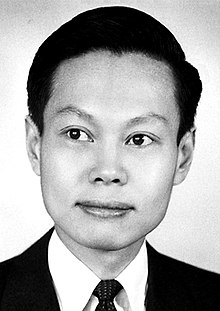
Back تشين يانج Arabic تشين يانج ARZ چن نینق یانق AZB Янг Чжэньнін Byelorussian Джъннин Ян Bulgarian চেন নিং ইয়াং Bengali/Bangla ཡང་ཀྲན་ཉིང་ Tibetan Chen Ning Yang Catalan Jang Čen-ning Czech Chen Ning Yang Danish
| Modern physics |
|---|
| |
Yang Chen-Ning or Chen-Ning Yang (Chinese: 杨振宁; pinyin: Yáng Zhènníng; born 1 October 1922),[1] also known as C. N. Yang or by the English name Frank Yang,[2] is a Chinese theoretical physicist who made significant contributions to statistical mechanics, integrable systems, gauge theory, and both particle physics and condensed matter physics. He and Tsung-Dao Lee received the 1957 Nobel Prize in Physics[3] for their work on parity non-conservation of weak interaction. The two proposed that one of the basic quantum-mechanics laws, the conservation of parity, is violated in the so-called weak nuclear reactions, those nuclear processes that result in the emission of beta or alpha particles. Yang is also well known for his collaboration with Robert Mills in developing non-abelian gauge theory, widely known as the Yang–Mills theory.
- ^ a b Li, Bing-An; Deng, Yuefan. "Biography of C.N. Yang" (PDF). Retrieved 11 September 2007.
His birth date was erroneously recorded as September 22, 1922 in his 1945 passport. He has since used this incorrect date on all subsequent official documents.
- ^ "Chen Ning Yang - Biographical". nobelprize.org. The Nobel Prize. Retrieved 29 June 2022.
- ^ "The Nobel Prize in Physics 1957". The Nobel Foundation. Retrieved 1 November 2014.


